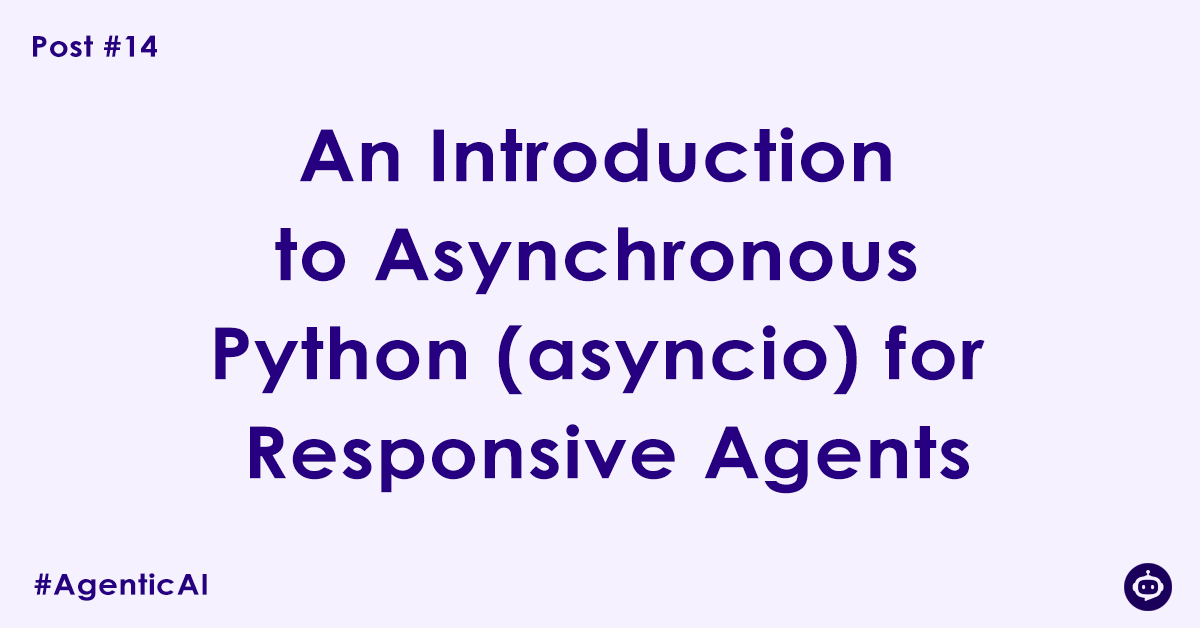We have our professional environment set up and our security protocols in place. We are on the verge of making our agent communicate with the outside world. But before we do, we need to talk about one of the most important concepts for building high-performance agents: waiting.
An AI agent’s life is full of waiting. It waits for a response from the LLM, it waits for a web search tool to return results, it waits for a database query to complete. In traditional programming, this waiting freezes the entire application. To build an agent that is fast and responsive, we need a better way to handle it.
That way is Asynchronous Python, using the built-in asyncio library.
The Tale of Two Chefs: Synchronous vs. Asynchronous
To understand the concept, let’s imagine a chef in a kitchen.
The Synchronous Chef:
This chef works on one dish from start to finish.
- Puts bread in the toaster.
- Stands and waits for 2 minutes for the toast to pop.
- Takes the toast, butters it.
- Puts a pan on the stove to heat up.
- Stands and waits for 1 minute for the pan to get hot.
- Fries an egg.
This chef is “blocked” by every waiting period. The kitchen’s output is slow and inefficient. This is how standard Python code works.
The Asynchronous Chef:
This chef is a master of multitasking.
- Puts bread in the toaster.
- While the toast is cooking (a 2-minute wait), they immediately put a pan on the stove.
- While the pan is heating up (a 1-minute wait), they get the eggs and butter out.
- The pan is now hot, so they start frying the egg.
- The toaster pops, and they butter the toast while the egg finishes.
This chef uses the “waiting” time from one task to make progress on others. The total time to prepare the meal is dramatically reduced. This is how asyncio works.
For an AI agent, calling an API is like toasting bread. With asyncio, while the agent is waiting for one API, it can be starting a request to another, making for a dramatically more efficient and responsive system.
The Key Ingredients of asyncio
asyncio introduces a few new keywords to Python that allow us to write code like our asynchronous chef.
- async def: The Magic FunctionWhen you put async before def, you’re creating a special type of function called a coroutine. Think of it as a task that can be paused and resumed. This is the fundamental building block of any async application.
- await: The Pause ButtonInside an async def function, you use the await keyword. This is the most important part. await tells Python: “This next operation is one of those ‘waiting’ tasks. I’m going to pause this function here and wait for it to finish, but you are now free to go and work on any other tasks that are ready to run.” This is the point where our chef turns away from the toaster to heat up the pan.
- asyncio.gather(): The Task ManagerThis is how you tell Python to run multiple “chef’s tasks” concurrently. You give asyncio.gather() a list of your awaitable tasks, and it will start them all, manage them while they are in their “waiting” states, and return the results when they are all complete.
A Practical Agentic Example
Let’s see the difference in a code example. Imagine our agent needs to call two different APIs (e.g., a weather API and a stock API), and each has a 2-second delay.
The Synchronous (Slow) Way
This is how you would write it traditionally.
import time
def fetch_data(tool_name):
print(f"Starting to fetch data for {tool_name}...")
# Simulate a 2-second network delay
time.sleep(2)
print(f"Finished fetching for {tool_name}.")
return f"Data from {tool_name}"
start_time = time.time()
data1 = fetch_data("Weather API")
data2 = fetch_data("Stock API")
end_time = time.time()
print(f"\nTotal time: {end_time - start_time:.2f} seconds")
# Result: Total time: 4.01 secondsThe program waits a full 2 seconds for the Weather API, and only then starts the 2-second wait for the Stock API, for a total of 4 seconds.
The Asynchronous (Fast) Way
Now, let’s rewrite it using asyncio.
import asyncio
import time
async def fetch_data_async(tool_name):
print(f"Starting to fetch data for {tool_name}...")
# Use asyncio.sleep() for non-blocking delay
await asyncio.sleep(2)
print(f"Finished fetching for {tool_name}.")
return f"Data from {tool_name}"
async def main():
start_time = time.time()
# Run both tasks concurrently and wait for them all to finish
results = await asyncio.gather(
fetch_data_async("Weather API"),
fetch_data_async("Stock API")
)
end_time = time.time()
print(f"\n{results}")
print(f"Total time: {end_time - start_time:.2f} seconds")
# This starts the asyncio event loop and runs our main function
asyncio.run(main())
# Result: Total time: 2.01 secondsHere, asyncio.gather() starts both fetch_data_async calls at roughly the same time. Both 2-second “waits” happen concurrently. The entire process takes only as long as the single longest task.
Conclusion
While it requires a slightly different way of thinking, asyncio is a superpower for building AI agents. An agent’s primary function often involves orchestrating multiple tools and API calls. Using asynchronous code is the difference between an agent that feels sluggish and one that feels intelligent and responsive.
For building high-performance, production-grade AI agents that need to interact with the outside world, asyncio is not just a “nice-to-have”—it’s an essential tool in your workshop.
Author

Experienced Cloud & DevOps Engineer with hands-on experience in AWS, GCP, Terraform, Ansible, ELK, Docker, Git, GitLab, Python, PowerShell, Shell, and theoretical knowledge on Azure, Kubernetes & Jenkins. In my free time, I write blogs on ckdbtech.com
